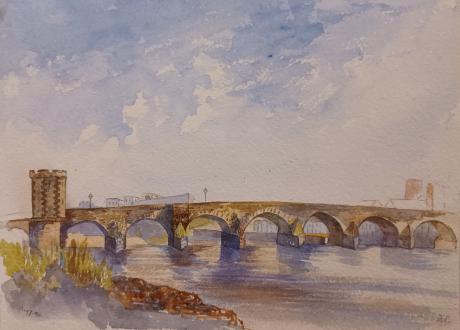"Bridge over the Moseelle at Coblentz Aug 7th 1875"
The Baldwin Bridge (German: Balduinbrücke) is a stone arch bridge over the Moselle in Koblenz, Germany. It is the oldest surviving bridge in the city and was built in the 14th century under Archbishop Baldwin of Luxembourg. The construction of a stone bridge over the Moselle began in 1332 during the reign of the Trier Elector Balduin of Luxembourg, after ferries had been used since the fall of the Roman bridge in the 2nd century.
While the bridge was still under construction, it was decided in 1338 to widen the bridge piers and to build the roadway entirely of stone instead of wood. The stones were quarried in the neighbouring Mosel village of Winningen, which can still be seen today from the vineyard location "Winninger Brückstück", the former quarry. Pope Clemens VI granted the sale of indulgences for the financing on the grounds that pilgrims would use the bridge. With the completion of the gate tower on the Lützel side, the bridge was completed in 1429. After military reconstruction and reinforcement of the bridge in the 17th and 18th centuries, it was occupied by the French in 1794 and the Nepomuk statue of 1740 was sunk. In Prussian times, the Balduin Bridge was also integrated into the city fortifications from 1830, with a traverse tower in Lützel and a large Moselle bridge gate. The gates disappeared with the demolition of the city wall in 1897. An anecdote reports that the Eighth Arch, called the Devil's Arch, was damaged in the ice drift of 1831 when Prussian artillery attempted to remove the ice by force of arms. Today this arch bears a red sandstone wall. In 1883 iron footbridges for pedestrians were installed and in 1895 the tram was led over the bridge. When the Wehrmacht withdrew on 07 March 1945, all bridges in Koblenz were blown up and the restored bridge could only be used again in 1949. From 1964 to 1970, six arches on the Lützel side were demolished in the course of the Moselle canalization and the bridge was doubled in width, completely removing the conversions of the 19th century. In memory of Balduin of Luxembourg, a statue of the Koblenz sculptor Rudi Scheuermann was inaugurated. In 2013, the medieval section was completely renovated and reinforced, as the bridge still carries a large proportion of the road traffic between the districts of Lützel, Neuendorf, Wallersheim, Altstadt and Neustadt.
Mary Keightley (1854-1946) was the youngest daughter of Archibald Keightley (1795-1877), executor of Sir Thomas Lawrence’s estate. She was a good amateur artist. Archibald Keightley (1795-1877), who was a solicitor who was the executor for Sir Thomas Lawrence, who had died earlier in 1830. Mr Keightley was responsible for the sale of Sir Thomas's collections, some of which were not paid for! There is a very interesting story about Sir Thomas's collection of old master drawings which were part of the assets Mr Keightley hadto dispose of. Following his work as a solicitor, Mr Keightley a few years later became the Registrar for the Charterhouse School, where he remained for 39 years.
Mary Keightley was born in 1854, in Charterhouse, Middlesex, England, United Kingdom, her father, Archibald Keightley, was 58 and her mother, Sarah Elizabeth Yates, was 41. She lived in London, England for about 20 years and Royal Borough of Kensington and Chelsea, London, England, United Kingdom in 1891. She died on 20 April 1946, in Camberley, Surrey, England, United Kingdom, at the age of 93.

